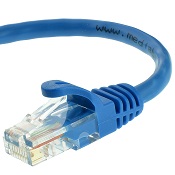What is an Ethernet Cable?
Ethernet cables are the backbone of wired local area networks (LANs) and wide area networks (WANs). These cables provide high-speed internet connectivity and are widely used in homes, offices, and data centers. In this article, we will take a closer look at what Ethernet cables are, their history, uses, advantages and disadvantages, and the different versions available.
History of Ethernet Cables
The Ethernet cable was first developed in the 1970s by Robert Metcalfe at Xerox PARC. The initial purpose of Ethernet was to connect computers to printers and other devices within a local network. Over time, Ethernet technology evolved and became the standard for high-speed data communication, allowing data to be transmitted over greater distances and at higher speeds.
Uses of Ethernet Cables
Ethernet cables are used to connect devices to networks and provide high-speed internet connectivity. Some of the most common uses of Ethernet cables include:
Connecting Computers and Laptops: Ethernet cables are used to connect desktop computers and laptops to the internet and local networks. This provides a stable and fast internet connection, making it ideal for tasks that require high bandwidth, such as video streaming and online gaming.
Connecting Printers and Scanners: Ethernet cables are also used to connect printers and scanners to networks. This allows multiple users to share a printer or scanner and reduces the need for individual devices to be connected directly to a computer.
Connecting Servers and Network Attached Storage (NAS) Devices: Ethernet cables are used to connect servers and NAS devices to networks, allowing users to store and share data and applications across multiple devices.
Connecting Smart TVs and Streaming Devices: Ethernet cables are used to connect smart TVs and streaming devices to the internet. This provides a stable and fast internet connection, allowing users to stream movies, TV shows, and music without buffering.
Connecting IP Cameras and Security Systems: Ethernet cables are used to connect IP cameras and security systems to networks. This allows users to monitor their home or business from anywhere, using a smartphone, tablet, or computer.
Pros and Cons of Ethernet Cables
Pros of Ethernet Cables
- Fast and Reliable: Ethernet cables provide a stable and fast internet connection, making them ideal for activities that require high bandwidth, such as online gaming, video conferencing, and data transfer.
- Secure: Ethernet cables are less susceptible to interference than wireless connections, making them more secure and less vulnerable to hacking.
- Easy to Install: Ethernet cables are relatively easy to install, and they require minimal configuration to get up and running.
- Suitable for Long Distances: Ethernet cables can transmit data over long distances without experiencing signal loss, making them ideal for large homes, offices, and data centers.
Cons of Ethernet Cables
- Limited Mobility: Ethernet cables require physical cables to be installed and connected between devices, making them less convenient for mobile devices.
- Limited Flexibility: Ethernet cables are limited by the length of the cable and the number of ports on your router or switch, making them less flexible than wireless alternatives.
- Installation: Installing Ethernet cables can be time-consuming and labor-intensive, especially in homes or offices where drilling and running cables through walls may be required.
- Cost: Ethernet cables can be more expensive than wireless alternatives, particularly for longer cables and higher-end versions.
Different Versions of Ethernet Cables
There are several different versions of Ethernet cables, each with different specifications and capabilities. The most common types are:
- Cat5: This is the earliest and most basic type of Ethernet cable. It supports data transfer rates of up to 100 Mbps and is suitable for most home networks.
- Cat5e: This version of Ethernet cable is an improved version of Cat5, supporting data transfer rates of up to 1 Gbps.
- Cat6: This type of Ethernet cable is designed for high-speed data transfer, with data transfer rates of up to 10 Gbps. It is suitable for large data centers and businesses that require high bandwidth.
- Cat6a: This version of Ethernet cable is similar to Cat6 but with better shielding, allowing for longer cable runs and less interference.
- Cat7: This is the most advanced type of Ethernet cable, supporting data transfer rates of up to 40 Gbps. It is suitable for large data centers and businesses that require very high bandwidth.
Final words
Ethernet cables are an essential component of modern networks, providing reliable and fast internet connectivity. Despite the rise of wireless technology, Ethernet cables remain the preferred choice for high-bandwidth applications such as gaming, video conferencing, and data centers. With several different versions available, choosing the right Ethernet cable depends on your specific needs and requirements.

